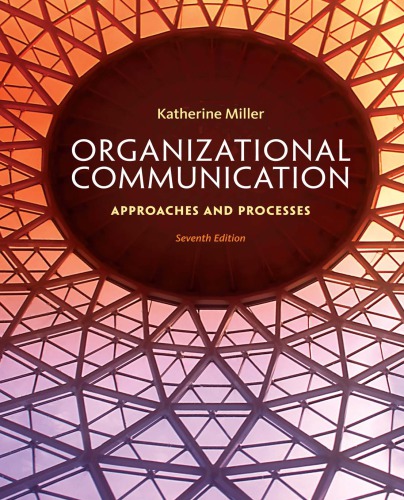

Most ebook files are in PDF format, so you can easily read them using various software such as Foxit Reader or directly on the Google Chrome browser.
Some ebook files are released by publishers in other formats such as .awz, .mobi, .epub, .fb2, etc. You may need to install specific software to read these formats on mobile/PC, such as Calibre.
Please read the tutorial at this link. https://ebooknice.com/page/post?id=faq
We offer FREE conversion to the popular formats you request; however, this may take some time. Therefore, right after payment, please email us, and we will try to provide the service as quickly as possible.
For some exceptional file formats or broken links (if any), please refrain from opening any disputes. Instead, email us first, and we will try to assist within a maximum of 6 hours.
EbookNice Team

Status:
Available4.6
35 reviews
ISBN 10: 1285164202
ISBN 13: 9781285164205
Author: Katherine Miller, Joshua Barbour
ORGANIZATIONAL COMMUNICATION: APPROACHES AND PROCESSES presents organizational communication from both a communication and managerial perspective. Professor Miller's clear writing style and consistent use of examples and case studies result in a text that undergraduate students will find easy to understand.
Chapter 1. The Challenge of Organizational Communication
Our Complicated World
Globalization
Global Insecurity
Climate Change
Changing Demographics
Complicating Our Thinking about Organizations
Complicating Our Thinking about Communication
Looking Ahead
Discussion Questions
Key Concepts
Chapter 2. Classical Approaches
The Machine Metaphor
Henri Fayol’s Theory of Classical Management
Elements of Management
Principles of Management
Principles of Organizational Structure
Summary of Fayol’s Theory
Max Weber’s Theory of Bureaucracy
Frederick Taylor’s Theory of Scientific Management
Impetus for the Theory of Scientific Management
Components of Scientific Management
Communication in Classical Approaches
Content of Communication
Direction of Communication Flow
Channel of Communication
Style of Communication
Classical Management in Organizations Today
Classical Structure in Today’s Organizations
Classical Job Design, Surveillance, and Rewards in Today’s Organizations
Summary
Discussion Questions
Key Concepts
Case Study. The Creamy Creations Takeover
Chapter 3. Human Relations and Human Resources Approaches
The Human Relations Approach
From Classical Theory to Human Relations: The Hawthorne Studies
Maslow’s Hierarchy of Needs Theory
McGregor’s Theory X and Theory Y
The Human Resources Approach
Impetus for the Human Resources Approach
Blake and Mouton’s Managerial Grid
Likert’s System IV
Communication in Human Relations and Human Resources Organizations
Content of Communication
Direction of Communication Flow
Channel of Communication
Style of Communication
Human Relations and Human Resources Organizations Today
The What of Human Resources Programs
The How of Human Resources Programs
Summary
Discussion Questions
Key Concepts
Case Study. Teamwork at Marshall’s Processing Plant
Chapter 4. Systems and Cultural Approaches
The Systems Metaphor and Systems Concepts
System Components
System Processes
System Properties
Systems Approaches to Organizational Communication
Communication Networks
Karl Weick’s Theory of Organizing
The Cultural Metaphor
Prescriptive Approaches to Culture
Descriptive and Explanatory Approaches to Culture
Summary
Discussion Questions
Key Concepts
Case Study. The Cultural Tale of Two Shuttles
Chapter 5. Constitutive Approaches
Communicative Constitution of Organizations
The Montreal School
Text and Conversation
Constitution as “Scaling Up”
Current Directions
The Four Flows
Membership Negotiation
Self-Structuring
Activity Coordination
Institutional Positioning
Summary and Challenges for Constitutive Approaches
Discussion Questions
Key Concepts
Case Study. A Drop in the Bucket
Chapter 6. Critical and Feminist Approaches
Critical Approaches
The Pervasiveness of Power
Ideology and Hegemony
Emancipation
Resistance
A Theory of Concertive Control
Feminist Approaches
Sexual Harassment
Discourse at Women-Led Businesses
Disciplined Bodies
Summary
Discussion Questions
Key Concepts
Case Study. Talking Turkey
Chapter 7. Socialization Processes
Models of Organizational Socialization
Phases of Socialization
Content of Socialization
Summary of Socialization Models
Communication Processes During Socialization
Recruiting and Interviewing
Newcomer Information-Seeking Tactics
Role Development Processes
Organizational Exit
Summary
Discussion Questions
Key Concepts
Case Study. The Church Search
Chapter 8. Decision-Making Processes
Models of the Decision-Making Process
Rational Models of Decision Making
Alternatives to Rational Models
Small-Group Decision Making
Descriptive Models of Small-Group Decision Making
Effective Small-Group Decision Making
Beyond Rational Group Processes
Participation and Collaboration
Participation in Decision-Making
Workplace Democracy
Collaboration Processes
Communication and Organizational Knowledge
Summary
Discussion Questions
Key Concepts
Case Study. Too Many Majors
Chapter 9. Conflict Management Processes
Conceptualizing the Conflict Process
Defining Conflict
Levels of Organizational Conflict
Phases of Organizational Conflict
Managing Organizational Conflict
Conflict Styles
Bargaining and Negotiation
Third-Party Conflict Resolution
Factors Influencing The Conflict Management Process
Personal Factors
Relational Factors
Cultural Factors
A Feminist View of Conflict
Summary
Discussion Questions
Key Concepts
Case Study. The Problem with Teamwork
Chapter 10. Organizational Change and Leadership Processes
Organizational Change Processes
The Complexity of Organizational Change
Reactions to Organizational Change
Communication in the Change Process
“Unplanned” Change: Organizational Crisis
Organizational Leadership
Models of Leadership
Communication and Leadership
Summary
Discussion Questions
Key Concepts
Case Study. Leading Nurses through Hospital Change
Chapter 11. Processes of Emotion in the Workplace
Emotion in the Workplace
Emotion as Part of the Job
Emotion as Part of Workplace Relationships
Emotion Rules and Emotional Intelligence
Stress, Burnout, and Social Support in the Workplace
Burnout
Communication as a Cause of Burnout
Coping with Burnout
Summary
Discussion Questions
Key Concepts
Case Study. Inexplicable Events
organizational communication ebook
organizational communication a lifespan approach ebook
organizational communication approaches and processes ebook
what is the best book on communication
what is organizational communication
Tags: Katherine Miller, Joshua Barbour, Communication, Approaches